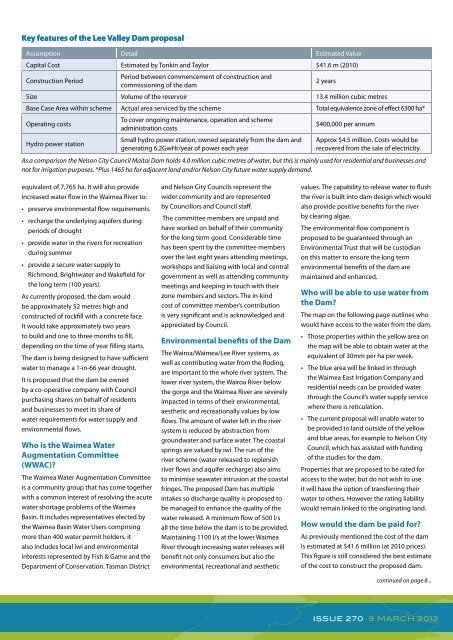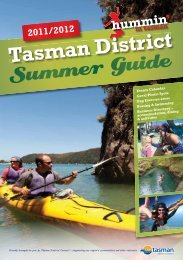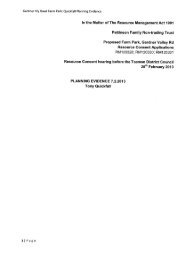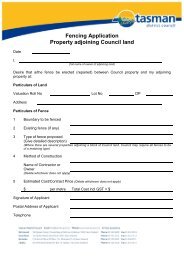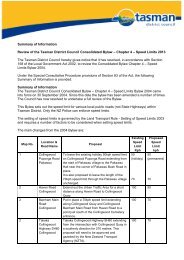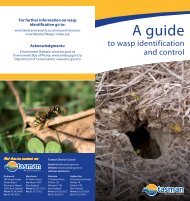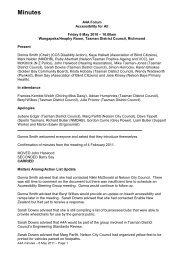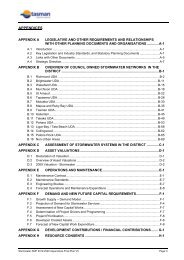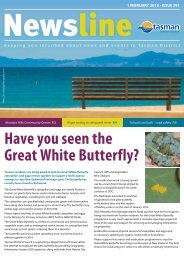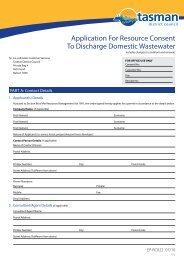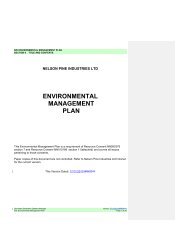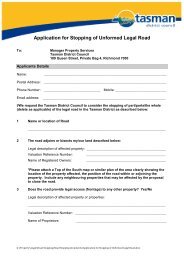Newsline 270 - 9 March 2012 - Tasman District Council
Newsline 270 - 9 March 2012 - Tasman District Council
Newsline 270 - 9 March 2012 - Tasman District Council
You also want an ePaper? Increase the reach of your titles
YUMPU automatically turns print PDFs into web optimized ePapers that Google loves.
Key features of the Lee Valley Dam proposal<br />
Assumption Detail Estimated Value<br />
Capital Cost Estimated by Tonkin and Taylor $41.6 m (2010)<br />
Construction Period<br />
Period between commencement of construction and<br />
commissioning of the dam<br />
2 years<br />
Size Volume of the reservoir 13.4 million cubic metres<br />
Base Case Area within scheme Actual area serviced by the scheme Total equivalence zone of effect 6300 ha*<br />
Operating costs<br />
To cover ongoing maintenance, operation and scheme<br />
administration costs<br />
$400,000 per annum<br />
Hydro power station<br />
Small hydro power station, owned separately from the dam and<br />
generating 6.2GwHr/year of power each year<br />
Approx $4.5 million. Costs would be<br />
recovered from the sale of electricity.<br />
As a comparison the Nelson City <strong>Council</strong> Maitai Dam holds 4.0 million cubic metres of water, but this is mainly used for residential and businesses and<br />
not for irrigation purposes. *Plus 1465 ha for adjacent land and/or Nelson City future water supply demand.<br />
equivalent of 7,765 ha. It will also provide<br />
increased water flow in the Waimea River to:<br />
• preserve environmental flow requirements<br />
• recharge the underlying aquifers during<br />
periods of drought<br />
• provide water in the rivers for recreation<br />
during summer<br />
• provide a secure water supply to<br />
Richmond, Brightwater and Wakefield for<br />
the long term (100 years).<br />
As currently proposed, the dam would<br />
be approximately 52 metres high and<br />
constructed of rockfill with a concrete face.<br />
It would take approximately two years<br />
to build and one to three months to fill,<br />
depending on the time of year filling starts.<br />
The dam is being designed to have sufficient<br />
water to manage a 1-in-66 year drought.<br />
It is proposed that the dam be owned<br />
by a co-operative company with <strong>Council</strong><br />
purchasing shares on behalf of residents<br />
and businesses to meet its share of<br />
water requirements for water supply and<br />
environmental flows.<br />
Who is the Waimea Water<br />
Augmentation Committee<br />
(WWAC)?<br />
The Waimea Water Augmentation Committee<br />
is a community group that has come together<br />
with a common interest of resolving the acute<br />
water shortage problems of the Waimea<br />
Basin. It includes representatives elected by<br />
the Waimea Basin Water Users comprising<br />
more than 400 water permit holders, it<br />
also includes local iwi and environmental<br />
interests represented by Fish & Game and the<br />
Department of Conservation. <strong>Tasman</strong> <strong>District</strong><br />
and Nelson City <strong>Council</strong>s represent the<br />
wider community and are represented<br />
by <strong>Council</strong>lors and <strong>Council</strong> staff.<br />
The committee members are unpaid and<br />
have worked on behalf of their community<br />
for the long term good. Considerable time<br />
has been spent by the committee members<br />
over the last eight years attending meetings,<br />
workshops and liaising with local and central<br />
government as well as attending community<br />
meetings and keeping in touch with their<br />
zone members and sectors. The in-kind<br />
cost of committee member’s contribution<br />
is very significant and is acknowledged and<br />
appreciated by <strong>Council</strong>.<br />
Environmental benefits of the Dam<br />
The Wairoa/Waimea/Lee River systems, as<br />
well as contributing water from the Roding,<br />
are important to the whole river system. The<br />
lower river system, the Wairoa River below<br />
the gorge and the Waimea River are severely<br />
impacted in terms of their environmental,<br />
aesthetic and recreationally values by low<br />
flows. The amount of water left in the river<br />
system is reduced by abstraction from<br />
groundwater and surface water. The coastal<br />
springs are valued by iwi. The run of the<br />
river scheme (water released to replenish<br />
river flows and aquifer recharge) also aims<br />
to minimise seawater intrusion at the coastal<br />
fringes. The proposed Dam has multiple<br />
intakes so discharge quality is proposed to<br />
be managed to enhance the quality of the<br />
water released. A minimum flow of 500 l/s<br />
all the time below the dam is to be provided.<br />
Maintaining 1100 l/s at the lower Waimea<br />
River through increasing water releases will<br />
benefit not only consumers but also the<br />
environmental, recreational and aesthetic<br />
values. The capability to release water to flush<br />
the river is built into dam design which would<br />
also provide positive benefits for the river<br />
by clearing algae.<br />
The environmental flow component is<br />
proposed to be guaranteed through an<br />
Environmental Trust that will be custodian<br />
on this matter to ensure the long term<br />
environmental benefits of the dam are<br />
maintained and enhanced.<br />
Who will be able to use water from<br />
the Dam?<br />
The map on the following page outlines who<br />
would have access to the water from the dam.<br />
• Those properties within the yellow area on<br />
the map will be able to obtain water at the<br />
equivalent of 30mm per ha per week.<br />
• The blue area will be linked in through<br />
the Waimea East Irrigation Company and<br />
residential needs can be provided water<br />
through the <strong>Council</strong>’s water supply service<br />
where there is reticulation.<br />
• The current proposal will enable water to<br />
be provided to land outside of the yellow<br />
and blue areas, for example to Nelson City<br />
<strong>Council</strong>, which has assisted with funding<br />
of the studies for the dam.<br />
Properties that are proposed to be rated for<br />
access to the water, but do not wish to use<br />
it will have the option of transferring their<br />
water to others. However the rating liability<br />
would remain linked to the originating land.<br />
How would the dam be paid for?<br />
As previously mentioned the cost of the dam<br />
is estimated at $41.6 million (at 2010 prices).<br />
This figure is still considered the best estimate<br />
of the cost to construct the proposed dam.<br />
continued on page 8...<br />
ISSUE <strong>270</strong> 9 MARCH <strong>2012</strong>


